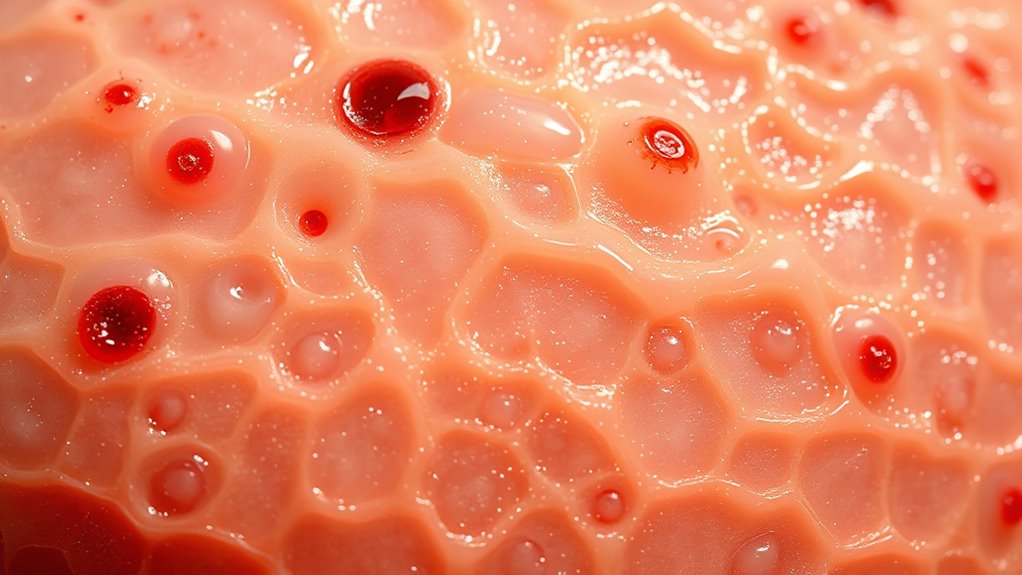After UV exposure, your skin activates repair pathways to fix DNA damage and boost collagen production. The body starts by recognizing and removing damaged DNA through nucleotide excision repair, preventing mutations that could lead to cancer. Simultaneously, it stimulates fibroblasts to produce new collagen, restoring skin strength and elasticity. However, ongoing UV exposure weakens these processes, accelerating aging. Continuing to explore will reveal how protective measures can support your skin’s natural recovery efforts.
Key Takeaways
- UV radiation causes DNA damage that activates nucleotide excision repair pathways to remove and replace damaged DNA segments.
- Proper repair prevents mutations, reducing skin cancer risk and maintaining normal cellular functions.
- UV exposure damages collagen, prompting skin to activate pathways that stimulate fibroblasts to produce new collagen fibers.
- Continuous UV exposure can overwhelm repair mechanisms, leading to accelerated skin aging and increased skin disorder risk.
- Protective measures like sunscreens, antioxidants, and collagen-stimulating ingredients support skin repair and long-term health.

When your skin is exposed to ultraviolet (UV) radiation, it triggers a complex series of repair mechanisms designed to fix damage and restore health. One of the primary issues caused by UV exposure is DNA damage within your skin cells. UV rays penetrate the epidermis, leading to the formation of thymine dimers and other mutations that can impair normal cellular functions. Your skin responds by activating nucleotide excision repair pathways, which identify and remove these damaged sections of DNA. Specialized enzymes then synthesize new DNA strands to replace the compromised segments, ensuring that your cells can continue to divide and function properly. This process is essential because unresolved DNA damage can lead to mutations and increase your risk of skin cancer.
In addition to repairing DNA, your skin initiates processes to rebuild the structural framework that keeps it firm and resilient. Collagen synthesis plays a critical role here. Collagen, a key protein in your skin’s extracellular matrix, provides strength and elasticity. When UV rays damage your skin, they stimulate an inflammatory response but also impair collagen production by fibroblasts—the cells responsible for collagen synthesis. To counteract this, your body ramps up repair mechanisms aimed at restoring collagen levels. This involves signaling pathways that activate fibroblasts to produce new collagen fibers. However, repeated UV exposure can lead to decreased collagen synthesis over time, resulting in wrinkles, sagging, and a loss of skin firmness.
Your skin’s repair pathways are constantly working to counteract UV-induced damage, but they have their limits. The repair of DNA damage is essential for preventing mutations, while increased collagen synthesis helps maintain skin’s structural integrity. Yet, if UV exposure continues unabated, these mechanisms can become overwhelmed, leading to premature aging and increased cancer risk. Protective measures, like using broad-spectrum sunscreens, wearing protective clothing, and avoiding peak sunlight hours, support these natural repair processes by minimizing damage from the outset. Also, certain skin care products with antioxidants and growth factors can boost collagen synthesis and enhance DNA repair, aiding your skin’s resilience. Incorporating reliable skincare products that contain ingredients like retinoids and vitamin C can further stimulate collagen production and repair mechanisms. By understanding how your skin repairs itself after UV exposure, you can better appreciate the importance of protecting it, not just to prevent immediate harm but to preserve your skin’s long-term health and appearance.
Frequently Asked Questions
How Long Does Skin Take to Fully Recover After UV Damage?
Your skin typically takes about 2 to 4 weeks to fully recover after UV damage. During this time, cell turnover speeds up to replace damaged cells, and collagen synthesis ramps up to restore skin firmness. Factors like age, skin type, and the extent of damage influence recovery time. To support healing, protect your skin from further UV exposure, stay hydrated, and consider using skincare products that boost collagen production.
Can Skincare Products Speed up UV Skin Repair?
Yes, skincare products can help speed up UV skin repair. Look for products with hydration benefits, which support your skin’s healing process, and antioxidant effects, which combat free radical damage caused by UV exposure. These ingredients boost your skin’s recovery, reduce inflammation, and promote healthier cell regeneration. Consistent use of such products enhances your skin’s natural repair pathways, helping you recover faster and maintain better overall skin health after sun damage.
Are There Genetic Factors Influencing UV Skin Repair Efficiency?
Yes, your genetic predispositions influence your UV skin repair efficiency. Some people naturally produce more repair proteins or have stronger antioxidant defenses, which help fix UV damage faster. Others may have genetic variations that slow down the repair process, making their skin more susceptible to damage and aging. Knowing your genetic makeup can guide personalized skincare strategies to enhance your skin’s ability to recover from UV exposure effectively.
What Are the Early Signs of Inadequate Skin Repair Post-Uv Exposure?
Your skin’s warning signs are as clear as a thunderclap. If you notice intense redness, inflammation, peeling, or dryness after UV exposure, it’s a sign your repair process is struggling. These early indicators show your skin isn’t effectively fixing the damage, risking long-term harm. Pay attention to these symptoms, and give your skin extra care to support proper healing and prevent further deterioration.
How Does Age Affect the Skin’s Ability to Repair After UV Damage?
As you age, your skin’s ability to repair after UV damage decreases due to age-related skin changes and a decline in cellular regeneration. You may notice slower healing, increased signs of sun damage, and reduced collagen production. These changes make your skin less resilient, so protecting it becomes even more important. Staying consistent with sun protection and skincare helps support your skin’s repair processes as you get older.
Conclusion
Now you know the key skin repair pathways after UV exposure, from DNA repair to inflammation control. By boosting your body’s natural defenses and embracing protective practices, you can help skin stay strong and resilient. Remember, consistent care counters the corrosive effects of UV rays, cultivating healthier, happier skin. So, stay vigilant, moisturize meticulously, and shield yourself. With mindful measures, you can master the marvelous mechanisms that mend and maintain your magnificent skin.









